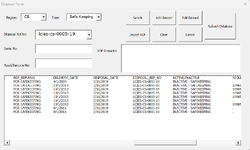amanphilip
New Member
- Joined
- Jul 4, 2023
- Messages
- 18
- Office Version
- 365
- 2019
- Platform
- Windows
Hello Good Day to All,
I am trying to populate a listbox after doing a search. I was able to do it however i want my code to be more efficient somehow the solution I am thinking is to do a loop to add the details in the listbox. However I am getting an error "Could not set the list property. Invalid Property value error". Hope you can help me please.
I am trying to populate a listbox after doing a search. I was able to do it however i want my code to be more efficient somehow the solution I am thinking is to do a loop to add the details in the listbox. However I am getting an error "Could not set the list property. Invalid Property value error". Hope you can help me please.
VBA Code:
If Not UserForm2.ComboBox1.Value = "" Then
'Search for the keyword
search = Format(StrConv(UserForm2.ComboBox1.Value, vbUpperCase))
Set searchR = ws.UsedRange
Set foundcell = searchR.Find(What:=search, LookIn:=xlValues, Lookat:=xlPart, MatchCase:=False)
'Check if the record was found
If Not foundcell Is Nothing Then
'
For i = 2 To lastrow
For x = 1 To Len(ws.Cells(i, 5))
a = UserForm2.ComboBox1.TextLength
If InStr(1, LCase(Mid(ws.Cells(i, 14), x, a)), search, vbTextCompare) > 0 Then
' Below is the code that I am getting an error : could not set the list property. Invalid property value error if I use for loop.
UserForm2.ListBox1.AddItem ws.Cells(i, 1)
UserForm2.ListBox1.List(UserForm2.ListBox1.ListCount - 1, 1) = ws.Cells(i, 2)
UserForm2.ListBox1.List(UserForm2.ListBox1.ListCount - 1, 2) = ws.Cells(i, 3)
UserForm2.ListBox1.List(UserForm2.ListBox1.ListCount - 1, 3) = ws.Cells(i, 4)
UserForm2.ListBox1.List(UserForm2.ListBox1.ListCount - 1, 4) = ws.Cells(i, 5)
UserForm2.ListBox1.List(UserForm2.ListBox1.ListCount - 1, 5) = ws.Cells(i, 6)
UserForm2.ListBox1.List(UserForm2.ListBox1.ListCount - 1, 6) = ws.Cells(i, 7)
UserForm2.ListBox1.List(UserForm2.ListBox1.ListCount - 1, 7) = ws.Cells(i, 8)
UserForm2.ListBox1.List(UserForm2.ListBox1.ListCount - 1, 8) = ws.Cells(i, 9)
UserForm2.ListBox1.List(UserForm2.ListBox1.ListCount - 1, 9) = ws.Cells(i, 10)
UserForm2.ListBox1.List(UserForm2.ListBox1.ListCount - 1, 10) = ws.Cells(i, 11)
UserForm2.ListBox1.List(UserForm2.ListBox1.ListCount - 1, 11) = ws.Cells(i, 12)
UserForm2.ListBox1.List(UserForm2.ListBox1.ListCount - 1, 12) = ws.Cells(i, 13)
UserForm2.ListBox1.List(UserForm2.ListBox1.ListCount - 1, 13) = ws.Cells(i, 14)
UserForm2.ListBox1.List(UserForm2.ListBox1.ListCount - 1, 14) = ws.Cells(i, 15)
UserForm2.ListBox1.List(UserForm2.ListBox1.ListCount - 1, 15) = ws.Cells(i, 16)
UserForm2.ListBox1.List(UserForm2.ListBox1.ListCount - 1, 16) = ws.Cells(i, 17)
UserForm2.ListBox1.List(UserForm2.ListBox1.ListCount - 1, 17) = ws.Cells(i, 18)
UserForm2.ListBox1.List(UserForm2.ListBox1.ListCount - 1, 18) = ws.Cells(i, 19)
'
End If
Next x
Next i
Set searchR = Nothing
Set foundcell = Nothing
Else
MsgBox "Record Not Found"
End If





